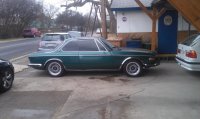Too cold to work on my E24, so I spent some time looking at the physics of the roll bar. Under no lateral load the chassis and forces look like this:
View attachment 174349
Here, RC is the roll center, GC is the gravitational center, Ho is the distance between RC and GC, and Xo is the distance between the center of the vehicle and the top of each spring (yes, this is a somewhat simplified suspension). Notice that the weight of the vehicle is split evenly between each wheel, and the deflection of the springs (YR and YL) is based on the spring constant and half the weight of the car.
Here is a car without any roll bar, when exposed to a lateral force Fc. This force acts on the GC, and since the GC is above the RC, it applies a torque Tc to the body. This torque is the lateral force Fc times the distance Ho between RC and GC. This torque then applies a downward force on one spring and an upward force on the other. These forces are equal and opposite, and are just the lateral force translated (via the torque equation) out to the part of the body pressing on the springs. To avoid a bunch of vector jazz, I simplified this by assuming the distance from the roll center to the spring is the same as the distance from the center of the car to the spring, and that the roll force is directly downward on the spring. So, roughly, the force on the spring is given by Fc(Ho/Xo). Note, because the body is free to roll, it does so, causing the lower arms to assume some angular relationship with the body, and, because of the forces, one spring compresses and the other extends. I have obviously exaggerated things here to show the effect.
View attachment 174350
Note that the force WL on the ground on the left side is now increased by The force applied to the spring, and the force WL on the left side is decreased by this same amount. Note too, as a cross check, that the sum of these forces equals the weight of the car, which it must, since the car is being held up by the ground and it is neither going through the ground, nor is it floating away.
Note too that while the force FC comes from the lateral cornering force applied to the GC, this force is carried by the deflection of the springs, which is proportional to the applied force. This is important, since this deflection is what the roll bar is going to control, and the amount of force it applies to the system depends on the deflection of the spring by the bar, and the spring constant Ks.
Now, let's introduce the roll bar. The roll bar is attached to the body, so it tries to roll with the body. In doing so, the lever end on the left side is deflected upwards as the angle between the body and the lower arm changes. This deflection is a result of the link (shown in green) having a fixed length, so wjhenm the arm moves the link moves and the arm must deflect. This deflection is translated to the right side of the car by the (here infinitely stiff) roll bar. So the roll bar pulls up the lower arm by the same amount the left arm was deflected.
Here is how this looks.
View attachment 174352
Note that the infinitely stiff bar has caused the deflection on theft side to be translated to the right side, and since the car must still sit on both wheels, the deflection (not the roll, but the deflection, of the lower arms) is about half of what it was with no roll bar. More importantly, the infinitely stiff bar means that the deflection on the right must be the same as the left, so all of the body roll is eliminated. What is really happening here is that the lateral force causing the torque on the body has been re-directed to deflect the springs on both sides of the car, causing the car to actually lower itself by an amount related to the spring rates and the lateral force on the car. Weird, but logical.. Note too that the weight on the left is different from the right by the difference between the roll induced force on the spring and the deflection of the bar times the spring constant. So, while there's still more weight on the left wheel, that increased weight, that would have occurred with no bar, is reduced by the force from the bar deflecting the spring (the KsYbar term), and the weight on the right wheel is increased by that same amount And, as must be the case, the total weight is still the weight of the car.
Now, obviously we do not have infinitely stiff roll bars, so in reality, the bar twists slightly, and not all of the body roll force is converted into lowering the car against its springs. The stiffness of the bar and the length of the bar levers determines how much roll feedback the system has.

